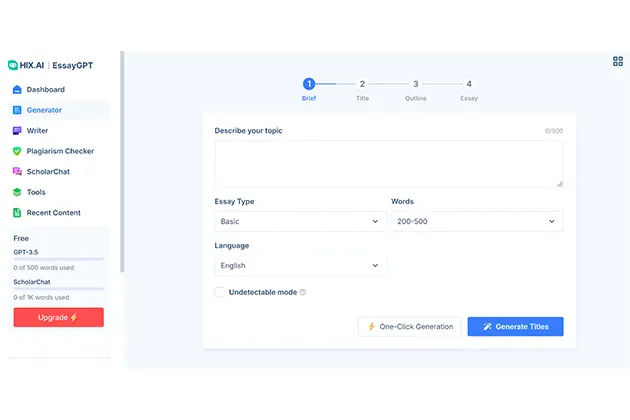Writing an effective essay can often feel like a daunting task, whether for academic purposes or personal projects. The process involves not just putting words on paper but also conducting research, organizing thoughts, and structuring arguments coherently. Fortunately, advancements in technology have introduced tools that can significantly ease this burden. One such tool is EssayGPT, an AI essay writing copilot that assists users in generating and refining their essays. This guide will explore how to effectively use AI tools like EssayGPT to enhance the essay writing process.
Understanding the Basics of Essay Writing
Before diving into how to utilize AI tools for essay writing, it’s essential to understand the fundamental components of a well-crafted essay.
The Structure of an Essay
Most essays follow a standard structure that includes:
- Introduction: This section introduces the topic and presents the thesis statement, which outlines the main argument or purpose of the essay.
- Body Paragraphs: These paragraphs provide evidence and analysis to support the thesis. Each paragraph should focus on a single point and include examples, data, or quotes from credible sources.
- Conclusion: The conclusion summarizes the main points and restates the thesis in light of the evidence presented. It may also suggest implications or areas for further research.
Utilizing AI Tools for Research
AI essay generator tools like EssayGPT can assist in this phase by providing access to vast databases of scholarly articles and studies. Users can input their topic into EssayGPT to receive summaries or insights from relevant academic sources. This can save time and ensure that the research is comprehensive.
Crafting Your Thesis Statement
The thesis statement is arguably one of the most critical components of an essay. It serves as the foundation upon which all arguments are built.
Tips for Writing a Strong Thesis Statement
- Be clear and concise; avoid vague language.
- Make sure it reflects your position on the topic.
- Ensure it can be supported with evidence throughout the essay.
Outlining Your Essay
Creating an outline is an effective way to organize thoughts and ensure that all necessary points are covered. An outline typically includes:
- Main ideas for each body paragraph
- Supporting details or evidence for each idea
- A logical flow from one point to another
Using AI Tools for Outlining
EssayGPT can help generate outlines based on the chosen topic and thesis statement. By inputting key ideas into EssayGPT, users can receive structured outlines that highlight main points and supporting arguments. This can streamline the writing process significantly.
Writing the Introduction
The introduction sets the tone for the entire essay. It should grab the reader’s attention while providing context for the topic.
Components of an Effective Introduction
- Hook: A compelling opening sentence that piques interest.
- Background Information: Brief context about the topic to inform readers.
- Thesis Statement: Clearly state your main argument.
Crafting Your Introduction with AI Assistance
Using tools like EssayGPT can aid in crafting introductions by suggesting engaging hooks or relevant background information based on current research trends related to your topic.
Developing Body Paragraphs
Each body paragraph should focus on a single idea that supports your thesis statement.
Structure of Body Paragraphs
- Topic Sentence: Introduces the main idea of the paragraph.
- Evidence: Provides data, quotes, or examples that support this idea.
- Analysis: Explains how this evidence relates back to your thesis.
- Transition Sentence: Links this paragraph to the next one smoothly.
Enhancing Body Paragraphs with AI Tools
EssayGPT can assist in generating content for body paragraphs by providing relevant evidence from academic sources or suggesting ways to analyze data effectively. Users can input their main ideas into EssayGPT and receive well-crafted paragraphs that require minimal editing.
Writing the Conclusion
The conclusion is your final opportunity to make an impression on your reader. It should not merely restate what has already been said but rather synthesize key points and offer final insights.
Elements of a Strong Conclusion
- Restate Thesis: Remind readers of your main argument.
- Summarize Key Points: Briefly go over major arguments made in body paragraphs.
- Final Thought: Leave readers with something to ponder—this could be a call to action or implications of your findings.
Using AI Tools for Conclusion Crafting
EssayGPT can help summarize key points effectively while ensuring that the conclusion resonates with readers. By inputting major arguments into EssayGPT, users can receive tailored conclusions that encapsulate their essays succinctly.
Editing and Proofreading Your Essay
Editing is a crucial step in ensuring that an essay is polished and free from errors.
The Importance of Editing
Effective editing involves checking for:
- Grammatical errors
- Spelling mistakes
- Clarity and coherence
- Consistency in tone and style
Leveraging AI for Editing Assistance
EssayGPT serves as an excellent AI essay editor by reviewing drafts for grammatical correctness and offering suggestions for improvement in clarity and structure. Users can input their completed drafts into EssayGPT to receive feedback on how to enhance their writing further.
Citing Sources Properly
Citing sources is essential in academic writing as it gives credit to original authors and helps avoid plagiarism.
Common Citation Styles
Familiarize yourself with different citation styles such as:
- APA (American Psychological Association)
- MLA (Modern Language Association)
- Chicago/Turabian style
Using AI Tools for Citation Generation
EssayGPT simplifies citation management by automatically generating citations in various formats based on user input. By entering source details into EssayGPT, users can ensure accurate citations without manually formatting them.
Final Review Before Submission
Before submitting any essay, it’s crucial to conduct one last review.
Checklist for Final Review
- Ensure all requirements are met (length, format).
- Check if all sources are cited correctly.
- Read through one last time for clarity and coherence.
- Confirm that your thesis is supported throughout.
Conclusion: Embracing AI Tools in Academic Writing
Writing an effective essay involves multiple steps—from choosing a topic and conducting research to drafting, editing, and citing sources properly. While this process may seem overwhelming at times, leveraging AI tools like EssayGPT can significantly enhance efficiency and quality throughout each phase of writing.
By integrating these advanced technologies into their writing process, students can not only save time but also improve their overall writing skills while producing high-quality essays that meet academic standards. Embracing these innovations allows writers to focus more on critical thinking and creativity rather than getting bogged down by logistical challenges associated with essay composition.
In summary, using AI tools like EssayGPT transforms traditional essay writing into a more manageable process—empowering individuals to express their ideas clearly while achieving academic success with confidence.











